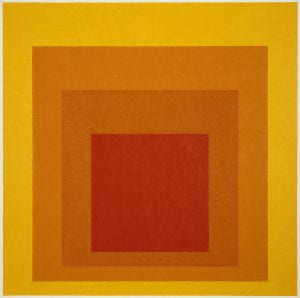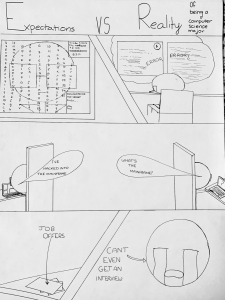Week #14
Week #13
Project #11
Josef Albers was born in Bottrop, Westphalia, Germany in 1888. His father had several occupations. In particular, his father was a house painter, carpenter, and handyman. This resulted in Albers’ childhood including experience with engraving glass, plumbing, and wiring. Albers’ childhood experiences helped to develop confidence when working with a wide range of materials.
Albers’ aptitude and interest in art education started early in his career. He worked as a teacher in Germany from 1908-1915. Starting in 1916, Albers began his career as an artist as a printmaker in Essen. During this period of time, he studied stained-glass making and received his first commission, which was a stained-glass window for a church in Essen. In 1919, Albers moved to Munich to study under Max Doerner and Franz Stuck in the Academy of Fine Arts, Munich. Three years later in 1922, Albers’ past experience with glass-painting landed him a position as a part of the faculty of German art school Bauhaus, where he taught newcomers about handicrafts. During this time, Albers started to experiment with various materials and abstract principles. In 1925, Albers was promoted to professor worked primarily with glass and designing furniture.
In 1933, Albers was offered a job as the head of the Black Mountain College in North Carolina. This change in employment was brought on by Albers’ emigration to the United States as a result of Bauhaus’ closure due to Nazi pressure. Albers held the position of the head of the painting program until 1949. Following his work at the Black Mountain College, Albers became the head of the department of design at Yale University in 1950, where he taught until his retirement in 1958. He continued to create art until his death in 1976. Albers’ 1947-1955 painting On Tideland marked his transition between Black Mountain College and Yale University. On Tideland was also painted at the same time as the earliest works of Albers’ most well-known series, Homage to the Square.
As an educator, Albers focused on giving students direct experience in working with a plethora of materials. This resulted in a teaching style where Albers would have students create constructions with a variety of materials to introduce them to their characteristics and structural properties.
As an artist, however, Albers explored color theory and composition. He favored a very disciplined, mathematical, and methodical process when it came to creating compositions. For example, his series Homage to the Square featured hundreds of paintings featuring solid and colored squares of precise proportions layered together in one of a few set formats and arrangements. Albers also created a variety of other works, such as his 1959 gold-leaf mural, Two Structural Constellations and several album sleeves for Command Records. Regardless of the type of work, Albers’ art always experimented with simple shapes like squares, triangles, and circles, color theory, and various methods of arrangement. Many of Albers’ discoveries and findings were recorded and documented in his book, Interaction of Color, which was published in 1963. The book contained a meticulous record of Albers’ materials, processes, and experiments. His unique vision and passion helped him become one of the twentieth century’s most influential visual arts teachers.
Study for Sanctuary
Works Cited
“Josef Albers.” Smithsonian American Art Museum, americanart.si.edu/artist/josef-albers-46.
“Josef Albers.” Wikipedia, Wikimedia Foundation, 13 Jan. 2021, en.wikipedia.org/wiki/Josef_Albers.
Perishable. “Josef Albers – Visual Artist, Minimalist and Educator at Cerbera Gallery, Crossroads, KCMO.” Cerbera Gallery | Crossroads Arts District | KCMO, cerberagallery.com/portfolios/josef-albers/.
“Josef Albers in Mexico.” Apollo Magazine, 29 Oct. 2017, www.apollo-magazine.com/art-diary/joseph-albers-in-mexico-guggenheim/?map=active.
Student Work:
Project #10
Exercise #7
Homework #14
Homework 14: Secret of Drawing Part 2
While watching The Secret of Drawing 2, I was pleasantly surprised by the wide range of topics covered all under the umbrella of storytelling, between animation and comics from both the east and the west hemispheres of the world. Honestly, it was a bit refreshing to get to see art from the eastern part of the world (even if it’s just Japan) since most discussions around art are very Euro-centric. However, I enjoyed getting to see the work of Daniel Clowes, the creator of Eightball. I liked his use of comic books not only to tell a story but to explore and discuss portions of society, satire or not. Another artist whose work I found very fun was Sylvain Chomet. I got the opportunity to take a class on 2-D animation last semester, so getting to see an animator’s work focused on was very fun and interesting. The amount of labor to create even an animated film is quite astounding, to a point where even a single film takes several years and even five seconds of animation could take a single animator a week. Finally, the last artist that I was interested by was Katsushika Hokusai. The Great Wave is one of my favorite pieces, and so I was looking forward to seeing more works from the same artist. However, I was not expecting to see manga or early forms of manga created by the same artist who created The Great Wave. I really enjoyed seeing their full range of talents. Overall, I really enjoyed this episode and getting to see different aspects of storytelling through art, and more specifically through comics/manga and animation.










